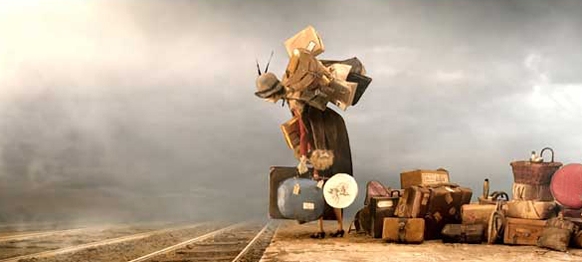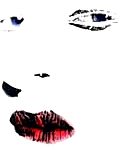|
|
|
A Model of Self-Preservation |
|
|
|
|
|
|
A gramophone record turns slowly to the melancholic music of a piano and clarinet. The camera pans across valises and suitcases, books and brooms, a rocker, lamps, a cheval mirror, a coat stand on its side and countless other items: picture frames, terracotta pots, a beach ball in a basket, an umbrella, parcels, and more suitcases and valises. Heading up this array of belongings and memorabilia, and weighed down at the edge of the platform with all she can carry on her person, Madame Tutli-Putli, nonplussed, waits for her train. Her red dress is stylishly modest, like her vintage felt hat. A moth flits about her head. Then a passenger train of indescribable length arrives at indescribable speed nearly blowing down Madame Tutli-Putli, clutching the brim of her cloche hat with both hands.
Inside Madame Tutli-Putli’s compartment, two men play chess on the baggage rack, each seated inside a suitcase. The bumping of the train reconfigures the pieces on the board until white’s king topples, and pipe-smoking black celebrates his victory, clapping his hands, pipe cradled against a thumb. Madame Tutli-Putli, sitting next to the window, is amused. She reads her Chatelaine, a coffee in a disposable cup on the small train table before her. Across from her, seated beside a snoozing old man, a child reads a book. She waves to the boy. He hides shyly behind his book called “How to Handle Your Enemies”. Rebuffed, Madame Tutli-Putli then notices the man directly opposite her whom she takes for a tennis pro because of the racket stored above his head. He eyes her legs and makes a lewd gesture with unmistakable intent. Unnerved, she is left to her solitude. This compartment scene is replete with detail: train cabin fixtures, the sole of the boy’s shoe, the tennis player’s checkered pants, the pale reflections of chess pieces in the metallic compartment wall, and items on the luggage racks, including skis and a bottle of champagne. Piano and clarinet play again, a little jazzier than before, with brushes on a snare at the steady pace of the moving train. The chessmen’s intellectual combat is quiet, interspersed with classical strings and ends with a sax wail. The jazzy theme resumes for the child, and slowly turns dark, a steamy sax honking for the athlete. Outdoors, the ground rushes past, trees drift by, the sun sinks in the sky, and the play of light alters accordingly, golden and bright until finally fading and red.
Madame Tutli-Putli is on her own, left to her own devices. In an NFB video interview, Maciek Szczerbowski, one of the film’s two creators, describes Madame Tutli-Putli as “a woman from another epoch, hopelessly lost in this one.” His co-creator Chris Lavis explains that she is a sort of deer caught in the headlights. Or we might say an elk, caught in the light of a fast train – though Madame Tutli-Putli’s fate is different from the elk’s.
The train is stopped, disquietingly still on the tracks in the middle of the night, a blue light running ominously the length of the undercarriage. Madame Tutli-Putli opens a window to look outside – nothing there, not at least that she can see. The other travellers in the compartment are asleep, the chess players in their suitcases, the boy on the old man’s lap, the tennis player wearing an eye mask. Without any obvious cause for concern, awake and by herself, she begins, with thoughtful hesitation, to write a letter. A moth flits about the light above her.
The whole time the train has been stopped we hear only ambient sounds created by David Bryant who also shared the musical direction for the film with Jean-Frédéric Messier. Boom! Someone – more than one, some people, beings, trod on the roof of the passenger car. The music resumes. Combined with Bryant’s effects, the sound is cacophonic and eerie. A giant propeller surrounding the engine’s headlight whirs to a start. The train creaks and groans picking up speed. Intruders with tar-like goo on their feet prowl the corridors. Their shadows fall on a sign warning against theft. Madame Tutli-Putli grabs her umbrella, pointing it defensively at the door to the compartment. She cannot see the intruders nor what they are doing: reconnecting hoses in the undercarriage. Green fumes rise in Madame Tutli-Putli’s compartment. Someone is tapping menacingly against the glass of the door. The tracks are on fire, the train torpedoing through the midnight wilderness. The train torpedoes
through the midnight wilderness, straight for an elk on the tracks. The wave of
the impact wakes Madame Tutli-Putli from her sleep. Drowsy, she stands and
teeters against the motion of the train. All the luggage in the compartment is
gone. Did she wake up, or is she asleep? Her travelling companions are gone. She
sits down again. Through her nearly closed eyelids, the tennis player fades into
view and the hideous intruders perform their terrible deed.
One of them
leans to her, a finger over his thin lips: “Sssshhh.”
This shot of her reflection, only a couple of seconds long, is but one example of the sharp editing and smart conception of this film. When the intruders jump to the roof of the train, the jump is from their perspective and the impact from Madame Tutli-Putli’s. When she is tempting to write a letter, we see the moth against the light from her perspective, and we see her eyes from the vantage point, not of the moth, but of the light, the moth flying blurrily close in the foreground. No less attention went
into the development of Madame Tutli-Putli’s character. She is a curious,
observant, and yet a tentative creature in confrontation with the world, and
maybe with herself. It is not enough that she waves to the boy across from her,
it is how she waves. It is how she struggles opening a stuck window when the
train is stopped in the night. She hesitates before writing a letter, then
writes with practiced, cursive handwriting. When the green fumes rise in her
compartment, she lifts her feet to her seat and crouches there frightened,
defensive, a hand over her mouth. Lavis and Szczerbowski developed her character
and her movements with the choreographic help of
Laurie Maher, who served as a live model for Madame Tutli-Putli. Maher also lent Madame Tutli-Putli her eyes. The puppets all have real human eyes digitally incorporated into the film by Jason Walker. Adding to the expressiveness of her behaviour and gestures, her eyes dramatically convey her feelings, reactions and moods, her distraction, her fright, her tearful weariness.
Until she steps into the corridor, Madame Tutli-Putli is almost always seated, and the world around her is relatively still. Now she is on her feet, responding to the motion and movements of the speeding train, even when she is leaning against a compartment window, hands held up as crescents shielding light from her eyes, the better to see inside. She looks down. She has stepped in the tar-like goo. If she was dreaming, she is in the dream, and if she wasn’t dreaming…. She runs, fleeing down the length of the train. She gets caught for a moment with one foot on either side of the gap between two cars jostling at high speed against each other. She keeps going, running, down one narrow train corridor after another, bumping against walls, running, and running out of breath until she falls to the floor of the quiet dining car. She looks up, eyes wet and red. A moth flits in the semi-lit room. She follows its flight to a tine on a fork. A solemn clarinet plays. The moth takes flight again, entreating her. Madame Tutli-Putli, walking with feminine poise, follows it out of the dining car. The music intensifies, orchestrally melded with mechanical reverberations. We are led to the headlight of the train, the moth's wings merging with the blurred motion of the propellers. Then there is just a bright circle of light, the moth barely visible as its centre. A silhouette image emerges, and the light fades. The final scene is a peaceful, still scene of the wilderness at dawn. "Madam Tutli-Putli" is a poetic film. The overall mood transcends the nebulous plot. There is a brave innocence about Madame Tutli-Putli. She is trusting but wary in the face of the dark and mysterious happenings on this fantastic train. She has her wits about her - until she is scared out of them. The recurring moth with its erratic flight draws her attention back to herself; it is a weightless counterpoint to the nightmarish events on this journey through the hinterland. Four years in the making, this 17-minute, stop-motion animation has deservedly won a spate of awards, including an Oscar nomination. "Madame Tutli-Putli" began with ideas about a train ride and a two-week train trip the animators took to learn about life on a long-distance train. Their conception about a Chaplinesque female character was refined with the modeling influence of a real person. Real eyes were tracked into place in the puppets. Sets were made by hand with found and scavenged items, scenery was painted for the backdrops, original music was scored and improvised, sounds were created. Lavis, Szczerbowski, and crew have created a totality of a world, an animated chef-d'oeuvre. |
|
Note: For many years, Lois Siegel taught at John Abbott College
(Montreal). |
|
|
|
|
|
|













